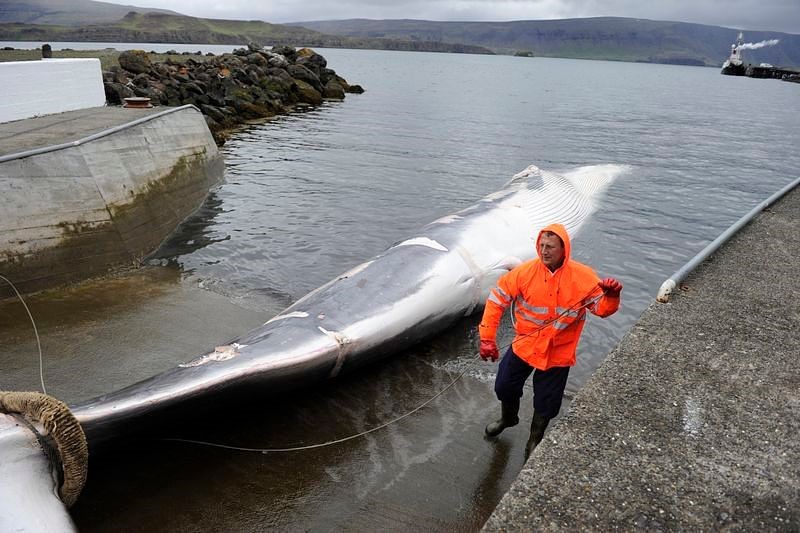Description

Disclaimer: Copyright infringement not intended.
Context
- Iceland's decision to resume hunting fin whales has raised concerns and sparked discussions about the ethics and sustainability of such practices.
Details
Resumption of Hunting
- Iceland resumed hunting fin whales in 2006 after a 20-year pause, which was followed by a suspension in June due to concerns about animal welfare.
- The IWC imposed a moratorium on commercial whaling in 1986 to protect whale populations.
- While some countries, including Iceland, Norway, and Japan, have continued commercial whaling despite the moratorium, it remains a contentious issue.
Animal Welfare Concerns
- The decision to resume hunting is rooted in the belief that the time it takes for harpooned whales to die violates Iceland's animal welfare laws. There are concerns about the suffering experienced by the whales during this process.
New Guidelines
- Iceland's government has introduced new guidelines aimed at reducing the suffering of the hunted fin whales.
- These guidelines include stricter requirements for hunting equipment, methods, and increased supervision.
- Whale hunters will also be required to complete a course in whale biology, pain perception, and stress.
Ethical and Conservation Debates
- The resumption of whaling activities raises ethical questions about the treatment of these intelligent and sensitive animals.
- It also contradicts the global efforts to protect whale populations and conserve marine biodiversity.
Sustainable Alternatives
- Advocates for whale conservation argue that sustainable alternatives to whaling, such as whale-watching tourism, can provide economic benefits while protecting whales and their habitats.

Background on Fin Whales
- Fin whales are the second-largest animals on Earth and are listed as vulnerable on the International Union for Conservation of Nature (IUCN) Red Lis
- Their populations were severely impacted by historical whaling.
- The fin whale, scientifically known as Balaenoptera physalus, is a marine mammal belonging to the family.
- Fin whales are baleen whales, characterized by their baleen plates used for filter-feeding.
Common Names
- The fin whale is also known by various common names, including the "finback whale," "razorback whale," and "common rorqual."
- These names often refer to its physical characteristics and behavior.
Physical Characteristics
Size and Shape
- Fin whales are among the largest animals on Earth, reaching lengths of up to 85 feet (26 meters).
- They have long, sleek bodies with a narrow, pointed head, and a prominent dorsal fin located about two-thirds of the way down their back.
Coloration and Markings
- Fin whales have a distinctive color pattern. They are dark gray to brownish-gray on their upper body and white on their underside.
- They often have asymmetrical coloration on their lower jaw, with a white right lower jaw and a dark left lower jaw.
Anatomy and Adaptations
- Like other baleen whales, fin whales have baleen plates in their mouths, which they use to filter tiny prey from the water.
- They have a large, grooved throat that can expand to accommodate large volumes of water during feeding.
- Their streamlined bodies and powerful tails make them fast swimmers.
Distribution and Habitat
Global Range
- Fin whales are found in oceans worldwide, inhabiting both temperate and polar regions.
- They are known for their extensive migrations, traveling between feeding and breeding areas.
Preferred Environments
- Fin whales prefer deep, offshore waters, where they feed on small schooling fish, krill, and other planktonic organisms.
- Breeding and calving occur in warmer, more sheltered waters.
Behavior and Biology
Feeding Habits
- Fin whales are filter feeders, swimming with their mouths open to engulf large volumes of water and prey.
- They use their baleen plates to filter out water and trap prey like krill and small fish.
Migration and Breeding
- They undertake long migrations between feeding and breeding areas, often covering thousands of miles.
- Breeding occurs during the winter months in low-latitude areas.
Social Structure
- Fin whales are typically solitary, but they can also form loose aggregations, especially during feeding.
- Limited information is available about their social behaviors compared to more social whale species.
Threats and Challenges
- Fin whales face threats from ship strikes, entanglement in fishing gear, habitat degradation, and noise pollution.
- Historical whaling severely reduced their populations.
- Fin whales are protected by international agreements like the International Whaling Commission's moratorium on commercial whaling.
- Conservation measures focus on reducing human impacts and monitoring population recovery.
Human Interaction
- Fin whales were historically targeted by whalers for their valuable blubber and meat.
- Today, human activities such as shipping and fishing pose threats to fin whales.
- Conservation efforts, including regulations on shipping lanes and fishing gear, aim to mitigate these impacts.
Significance in Ecosystems
- As filter feeders, fin whales play a crucial role in controlling plankton populations and maintaining the health of marine ecosystems.
- Keystone Species: Their presence and feeding behavior can have cascading effects on the abundance and distribution of prey species.

Conclusion
The decision to resume hunting fin whales in Iceland is a contentious issue that touches on ethics, animal welfare, conservation, and international agreements. It reflects a broader debate about the relationship between human activities and the well-being of wildlife and the environment.
|
PRACTICE QUESTION
Q. Which statement is true regarding Fin Whales (Balaenoptera physalus)?
1. Fin Whales are the smallest species of whales.
2. Fin Whales are listed as "Least Concern" on the IUCN Red List of Threatened Species.
3. Fin whales are found in oceans worldwide, inhabiting both temperate and polar regions.
Options:
A) Only Statement 1 is true.
B) Only Statement 2 is true.
C) Only Statement 3 is true.
D) Statements 2 and 3 are true.
Answer: C)
|
https://theprint.in/environment/iceland-resumes-fin-whale-hunting-but-killing-needs-to-be-faster/1741208/















